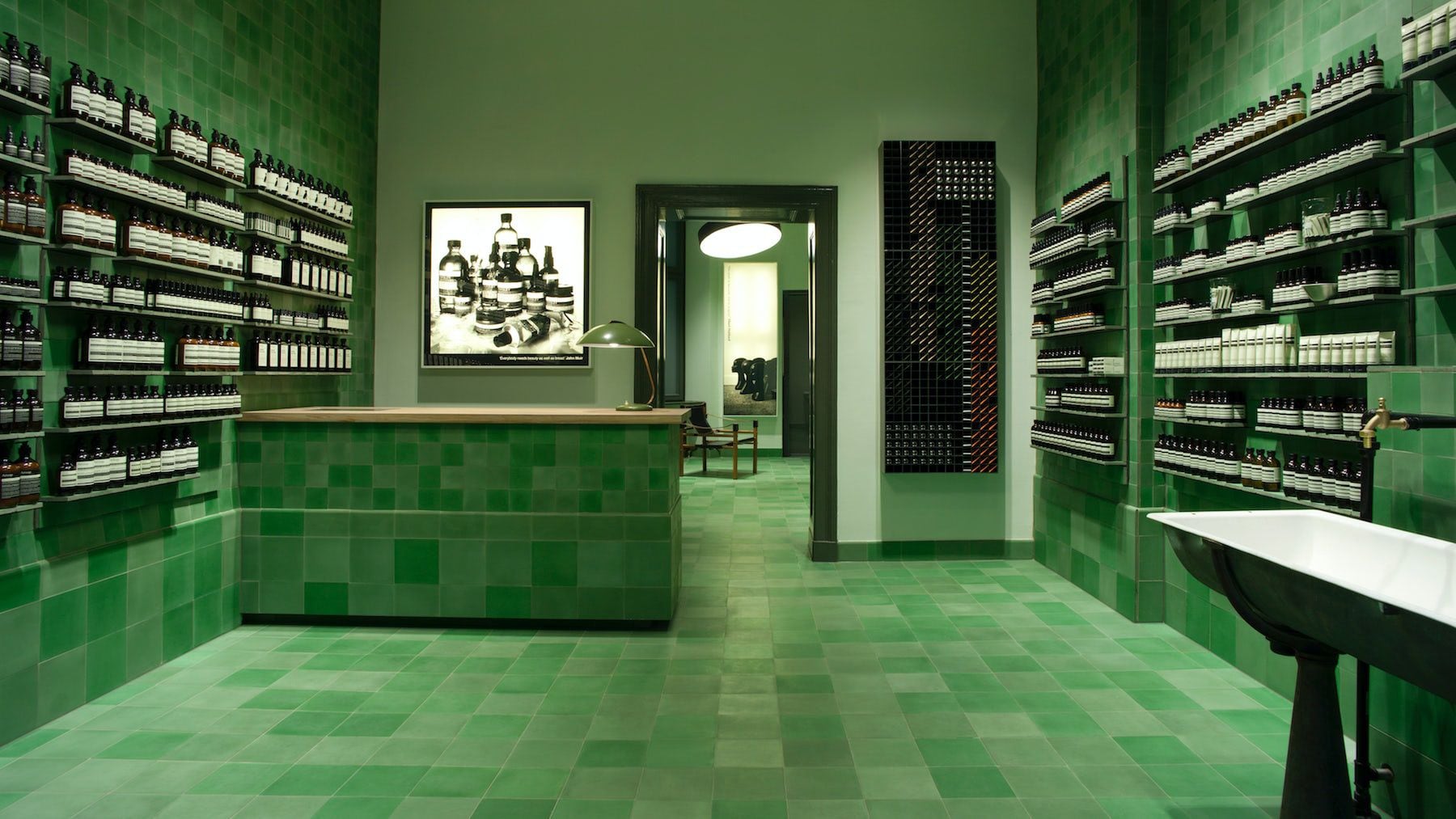
When Dallas Pratt worked at an outpost of Aesop in an outdoor shopping mall outside Chicago, one of her and her co-workers’ favourite ways of drawing in new customers was making a concoction they called “sidewalk tea.” They would put a few drops of scented lotion in a cup of hot water, and then they would pour it onto the slab of concrete outside the shop. As the water evaporated, the smell of the lotion would fill the air.
“It drew people in,” Pratt tells me. “They asked questions. They spent time.” And, crucially, they bought stuff.
This isn’t a novel marketing trick: stores that sell items with distinctive smells, such as perfumeries and bakeries, have been pumping smells out into streets and shopping malls probably since the beginning of retail. But starting in the 1990s, sense marketing became a more organised discipline, and now dozens of firms exist to help store owners develop distinctive custom smells.
But sidewalk tea, for Pratt, was also about creating an experience: “It was about hospitality more than ambience.” The salespeople would treat customers as though they were welcoming them into their own living rooms, offering drinks and chatting about things other than the products. The idea was to make people want to be inside Aesop, even if they’d gone to the mall with no intention of buying hand lotion.
As in-person retail continues to recover from the pandemic-era lockdowns, store owners and marketers are working hard to press the main advantage analogue shopping has over digital: its appeal to all the senses.
The most primal sense of all, the one that imprints most deeply on our memories, is smell. The brain processes odours in the olfactory cortex, located directly behind the nose and connected to key structures in the limbic system, including the amygdala, which forms emotional responses, and the hippocampus, which stores memories.
“No other sensory system co-opts the limbic system of the brain the way smell does,” says Rachel Herz, a neuroscientist at Brown University who also advises corporations about their scent strategy. “It’s doing the work of perception, emotion, emotional memory, learning, and association.”
Because smell is so closely linked with memory, not everyone will have the same reaction to a particular scent. While many people find the smell of lavender soothing, for instance, those who connect it to unpleasant memories may feel the opposite. This is another reason brands take the time and trouble to create unique scents that will be connected to them alone.
Aradhna Krishna, a professor of marketing at the University of Michigan, was one of the first researchers to study the intersection between the senses and branding. Two or more senses working in tandem, she discovered, are more powerful than one working alone: a photo of a chocolate chip cookie is nice, but that photo combined with the smell of cookies baking is likely to make you drool.
“Smells within products can enhance the memory of other attributes,” she says. “You remember brand names, what the shape of the product was, where you used it. The smell is uniquely related to the product.”
Even a gentle ambient smell has an effect. In one experiment, Alan Hirsch of the Smell and Taste Research Foundation placed two identical pairs of Nike running shoes in separate rooms that were also identical, except that one was scented and one was not. Customers were 84 percent more likely to buy the shoes in the scented room. (Nike, however, was dubious: “The big thing we try to do is get athletic shoes not to smell,” a spokeswoman told the New York Times at the time. Though it could be argued that new running shoes have an appealing smell all their own.)
Other experiments have shown that customers in pleasant-smelling spaces – not just stores, but also casinos and hotel lobbies – spend more time there without realising it, take more time to examine specific products, and are more likely to spend more money, including on impulse purchases. In some cases, customers are unaware that they’re smelling something that’s been specially designed to appeal to them: “new car smell,” for instance, is entirely artificial and has nothing to do with paint or upholstery.
How does a brand create the ideal signature scent? It’s a lengthy and complex process, says Neohni Gilligan, the director of fragrance and product marketing at ScentAir, one of the world’s largest scent marketing companies. It begins with a 50-100 item questionnaire for the client, though only one or two of those questions relate specifically to scent. The rest are about decor, colours, lighting, sound and music, customer demographics, and the brand’s overall ethos.
Some pairings seem obvious: a furniture shop may want to play up the smell of leather while Cinnabon should smell like fresh cinnamon rolls are baking just a few feet away (at Cinnabon stores, ovens are placed near the doors of the store so that the smell escapes into the street; when the company trialled a location with ovens placed at the back, sales decreased significantly).
Other scents are more about evoking feelings, but while a hotel lobby and a spa can both smell “relaxing”, in practice, these require a very different bouquet of scents.
Once Gilligan outlines the characteristics of a scent, she passes it along to ScentAir’s fragrance partners, who do the actual formulation, taking care to follow local safety guidelines because no smell is more memorable – in a bad way – than the one that caused a severe allergic reaction.
The next step is determining the intensity of the scent. Should the customer be bombarded by fragrance, as they are at Abercrombie & Fitch, which has been blasting its Fierce cologne for more than 20 years, or is the brand going for something more subtle that leaves more of a lingering impression?
“Sometimes,” says Caroline Fabrigas, CEO of Scent Marketing Inc, a scent branding firm, “true success is if the customer doesn’t think it smells of anything. It’s the brand speaking to you.”
Unlike perfumes, whose scents can evolve in conjunction with the wearer’s body chemistry, commercial smells need to remain constant. Scent marketers plan how the smell will be dispersed throughout the space. Sometimes they use the HVAC system, or introduce a visual element such as a candle or a reed diffuser. In the case of Singapore Airlines, the marketing team also incorporated the brand smell into soaps and hot towels. More often, though, spaces use strategically located mechanical diffusers, controlled through smartphones, that can be programmed to pump out scent at different times during the day. My local grocery store, for instance, starts smelling like rotisserie chicken in the afternoon, when shoppers are starting to think about dinner.
The total cost of scent branding varies, based on the size of the space and the complexity of the smell, ranging from $1,000 to many, many times that. Olivia Jezler, founder of the scent marketing firm Future of Smell, says stores spend millions of dollars on visual branding and music, and scent leaves a much more lasting impression than sound.
“At a lot of stores, especially cheaper stores like Zara, we can smell the plastic and the materials in the wall,” she says. “Subconsciously, that’s telling us something: no matter how much money is put into visual branding, this is something uncomfortable, something not safe and not good for us.”
Retail stores are still trying to find their way back from the pandemic, and both Fabrigas and Jezler believe that the next generation of flagship stores will be different from their predecessors. “During the pandemic, people weren’t able to be out in public and they wanted to be,” says Fabrigas. “Retail gives them reasons to come out and play. Stores won’t be just places to buy, they’ll also be places to have this visceral, immersive experience.” Fabrigas already has experience with this sort of space: she designed scents for the Museum of Ice Cream.
The brand experience can extend beyond the confines of a particular space and into the realm of e-commerce. Jezler thinks retailers are missing a huge opportunity by not including scent in their packaging. “Companies are spending a lot of money on beautiful unboxing experiences,” she says. “I ordered something from Chanel the other day, and I thought, ‘The packaging is so beautiful, but where’s the smell?’” It wouldn’t have been hard for the company to embed its signature No 5 scent into the packaging and connect, on an emotional level, to the customer at home.
On Friday afternoon, I went shopping in downtown Chicago, not to buy anything, but simply to smell. Zara on Michigan Avenue didn’t smell like plastic, exactly; more like cardboard and glue, but Jezler was still correct: it smelled temporary, like nothing on the racks had been made to last. At Ralph Lauren, candles in the company’s Green scent were available for purchase. Over on nearby Rush Street, Tommy Bahama reeked of coconut and someone’s idea of the tropics, Urban Outfitters smelled of cardboard mixed with grill smoke from the bar next door, and Abercrombie was Fierce as ever – Herz suggests that it’s been around so long, it’s actually become a nostalgic smell to former customers who are now the parents of teenage shoppers. Meanwhile Garrett Popcorn and Subway pumped their distinctive odours of burned sugar and overly sweet bread on to the sidewalk outside their storefronts,.
On Oak Street, lined with high-end designer boutiques, smells are more subtle, barely there, like “quiet luxury” and money itself; they’re mostly detectable in contrast to unpleasant outside odours like asphalt and car exhaust. At Chanel, this is deliberate: the stronger and more distinctive scents are confined to the area near the cosmetics counter. “We keep smells low to avoid sinus issues for customers and employees,” an employee told me. By contrast, Dior was arranged so that the combined aromas from the first-floor perfume display emanated throughout the entire store.
Armani was also deliberately scentless. A previous location on Michigan Avenue had smelled of Armani’s Bois d’Encens fragrance, said Antony de Angelo, a longtime employee who had worked in both stores. The scent was inspired by the designer’s childhood in Italy, specifically church, and it gave the space an international feel: for Europeans, it was a familiar smell in a faraway place, while for Americans, it evoked foreign travel.
Like Pratt, De Angelo considered the fragrance another way to welcome customers. “The smell was a talking point,” he said. “It was subtle, but people would always comment on it. They could sense it was something out of the ordinary. We don’t have the smell at the new store. I miss it.”
By Aimee Levitt
Sign up to The Business of Beauty newsletter, your complimentary, must-read source for the day’s most important beauty and wellness news and analysis.


